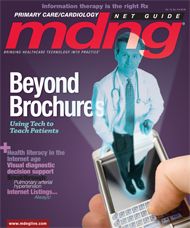Publication
Article
MDNG Primary Care
Tech Talk: Get Your Software on the Cheap
Does the word "free" grab your attention? It sure gets mine.
Does the word “free” grab your attention? It sure gets mine. In the universe of computing, free software has always been fairly commonplace. There are many reasons for this, starting with the fact that software doesn’t cost much to produce, except for intellectual eff ort, which some people choose to give away for free. While some programmers and vendors are motivated by altruism, others simply want to show off their programming skills, and others ultimately want to sell you a product. Whatever the reason vendors have for giving it away, you can benefi t from downloading and using freeware and shareware.
reeware is software that is available for use at no cost. Freeware is usually made available in a proprietary form that cannot be modifi ed, copied, or redistributed to somebody else. You can find freeware programs for virtually every computer platform, including Windows, Mac, UNIX, and DOS. Common examples of freeware include games, graphics (such as fonts and screensavers), offi ce productivity tools, and systems utilities.
Another form of “free” software is known as shareware. This “try-before-you-buy” software is a marketing method that allows the user to try out the software free of charge before purchasing it. Sometimes the trial version is the full version of the software; other times it off ers only a few of the product’s features. Google the word “freeware,” and you will retrieve many sites that offer a wide variety of programs for download. These sites generally allow users to review and comment on the software, so you can see what’s popular and highly rated by peers. To protect your data, make sure to stick with legitimate sites that are secure and free of viruses and spyware. CNET’s Download.com is a good place to start, and FreewareFiles.com is well organized and has a nice, clean interface.
Freeware 2.0
Google Docs is an excellent example of a new form of freeware: the Web 2.0 application that exists only online. Intended to compete with the Microsoft Office suite, these free programs let you create and save documents, spreadsheets, and presentations online. I briefl y tested the word processing program and found it adequate for most basic writing tasks. It is missing a few high-end features, such as automatic spellchecking and an unlimited number of fonts, but it should cover most users’ needs. It even lets you insert tables and comments. The stripped-down presentation program is also basic but is a great alternative to purchasing Microsoft PowerPoint if you create just one or two presentations per year.
Th ere are many freeware programs specifi cally written for medical professionals. Epocrates, for example, offers a free mobile drug and formulary reference. Two good sites for fi nding medically relevant freeware programs are Sofotex.com and DoctorsLounge.com. You can even find free versions of fairly sophisticated software, such as OpenEMR, which is licensed under the General Gnu Public License. It is a free, open source replacement for medical applications like Medical Manager, Health Pro, and Misys. One caveat: if knowing how to sync your PDA is basically the extent of your technical know-how, then this Linux program probably isn’t for you. As I mentioned, shareware is more of a sales technique than a way for you to get free software; however, it does deliver real value because it lets you “test drive” an application before you buy it. Many well-known companies (including Microsoft, Adobe, and many others) let users try versions of their products for free. In my own EHR business, I have always allowed potential customers to try Amazing Charts in their own practice for three months before being asked to pay for it, and I am consistently told that this is a major factor in their decision to eventually purchase the system.
Personally, before I purchase any software, I search for free alternatives (usually on Google). If I don’t fi nd a free product that fi ts my needs, I try to fi nd a shareware version of the software and run it through its paces before paying a penny.
Dr. Bertman is Physician Editor-in-Chief of MDNG: Primary Care/ Cardiology Edition. He is a Clinical Assistant Professor of Family Medicine at Brown University and president of AmazingCharts. com, a leading developer of EHR software. He is also the founder and president of AfraidToAsk.com, a consumer website focusing on personal medical topics. He is in private practice in Hope Valley, RI.






